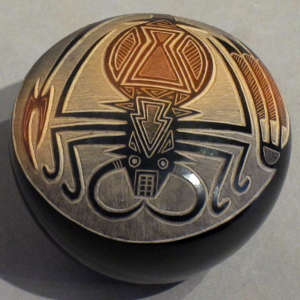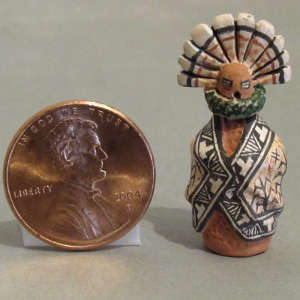Shapes and Forms: Miniatures

Miniature red nativity set with thirteen pieces
Linda Askan, Santa Clara
1.25 in H by 1 in Dia
Measurement of the largest piece

Black seed pot with a sgraffito eagle and geometric design
Art Cody, Kiowa/Santa Clara
2 in H by 1.75 in Dia
Miniatures have played a role in the Pueblo pottery world for more than 1000 years. Archaeologists found miniature pieces of pottery in the rubbish heaps at Chaco. Some were found in one of the older room blocks. Were they used as prototypes, something made small to see how it works before scaling it up? We don't know, but miniatures seem to have been part of the ceramic assemblage from many places since Chaco was abandoned. It may not seem as though they are as hard to create as larger pottery but the detailed decorations some potters put on their miniatures can make them be as time-consuming.
However, Art Cody (Haungooah, a Kiowa man who married into Santa Clara) once said, "I can make twice the amount of money by making miniatures. There's a bigger demand for miniatures and they're not that time consuming because there's a smaller area to work with. The larger pieces you put more time into it, and then if they do sell you've got to sit back and wait for a buyer to come in." But Art was at the top of his form when he spoke that and most of what he produced found its way to eager buyers before the dealers could get in between.
The official SWAIA miniature designation means the piece is less than 3.25 inches in its greatest dimension. There was a time just a few years ago when that definition read: Less than 2.25 inches in its greatest dimension. But then they noticed that only one or two potters were competing against each other in the miniatures category, so they broadened the definition.

Polychrome seed pot with a sgraffito and painted wolf and geometric design
Joseph Lonewolf, Santa Clara
1 in H by 1 in Dia

Miniature polychrome seed pot with sgraffito duck and geometric design
Rosemary Lonewolf, Santa Clara
1.5 in H by 1.25 in Dia

Black seedpot with a sienna spot and sgraffito scorpion design
Dean Haungooah, Santa Clara
1.75 in H by 2.25 in Dia
Of special note is Teresa Wildflower. Teresa is of the Chemehuevi tribe. The Chemehuevi spent probably a thousand years living in the heart of the Mojave Desert. They learned to make a primitive utilitarian pottery from their neighbors, the Mohave, but they were too nomadic to make very much of it. It was easier to trade for and they probably got a better, more consistent product anyway.
Teresa was born on the Colorado River Indian Reservation near Lake Havasu, AZ. The Chemehuevi Reservation was a few miles to the north but Parker Dam had been completed and Lake Havasu was filling. When full, Lake Havasu put half their reservation under water. To alleviate that problem, the federal government expanded the much larger Colorado River Indian Reservation south of Parker Dam and offered land to tribes and families being dislocated by the rising water.
In those days, the Bureau of Indian Affairs was also busy recruiting and relocating Hopi and Dineh families to the newly expanded reservation. Putting the timing and the stories together have suggested that one of Teresa's neighbors was a Hopi potter who taught her how to work with clay. Teresa then went on to carve out her own niche in the pottery world.
When Teresa made any kind of animal, bird or reptile figure, the scale was architecturally correct: usually 1 inch equal to one foot. I don't know how prolific she may have been but I have come across one collection that had more than 300 of her pieces. I've also come across mention of her doing a show at a pottery gallery in Albuquerque in 1982.






